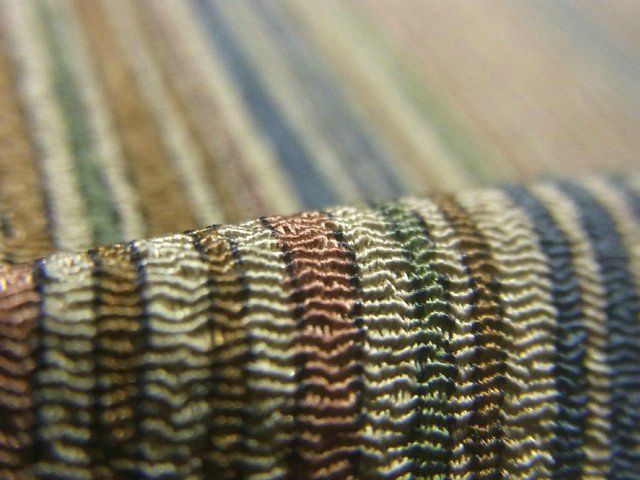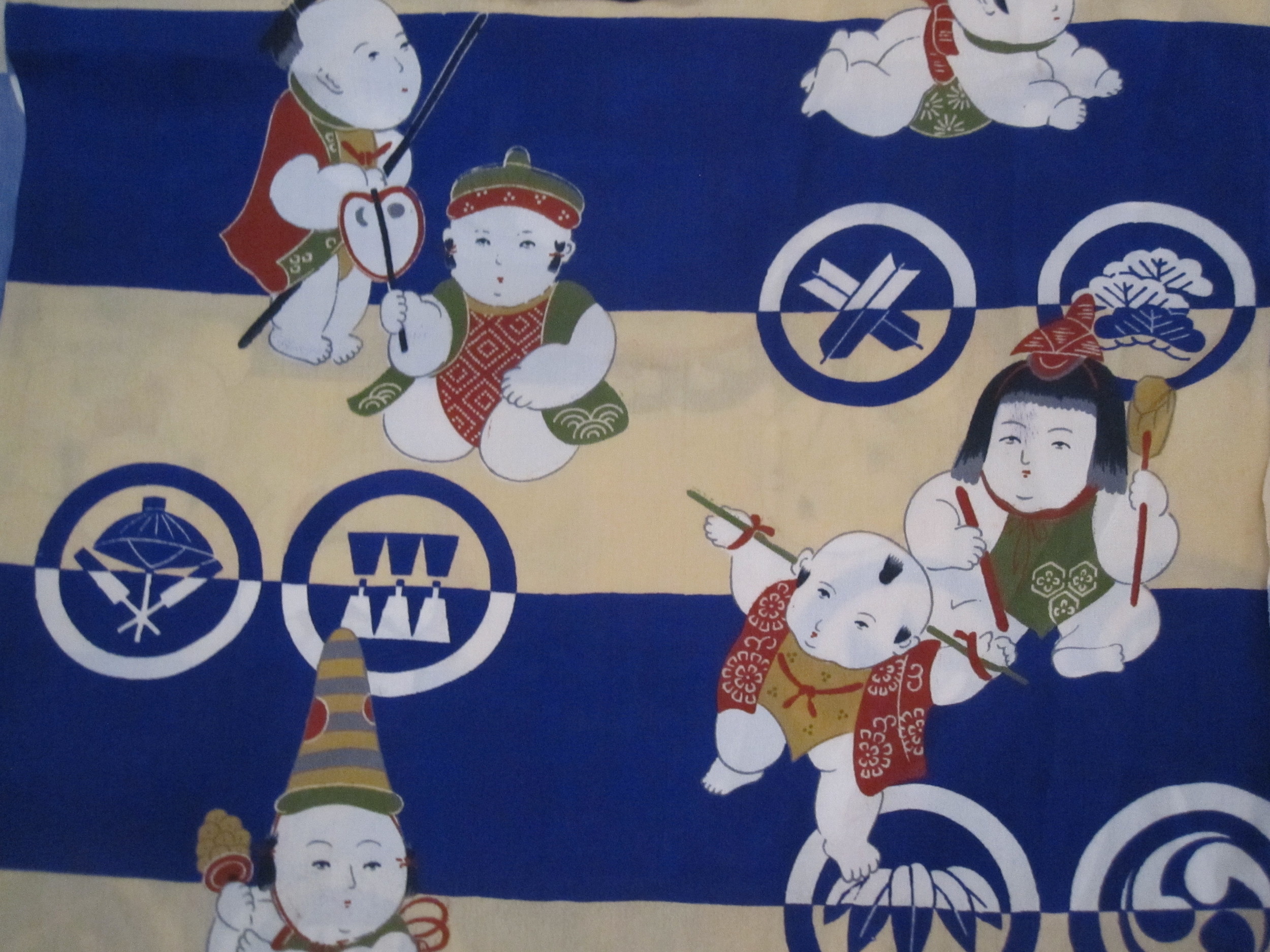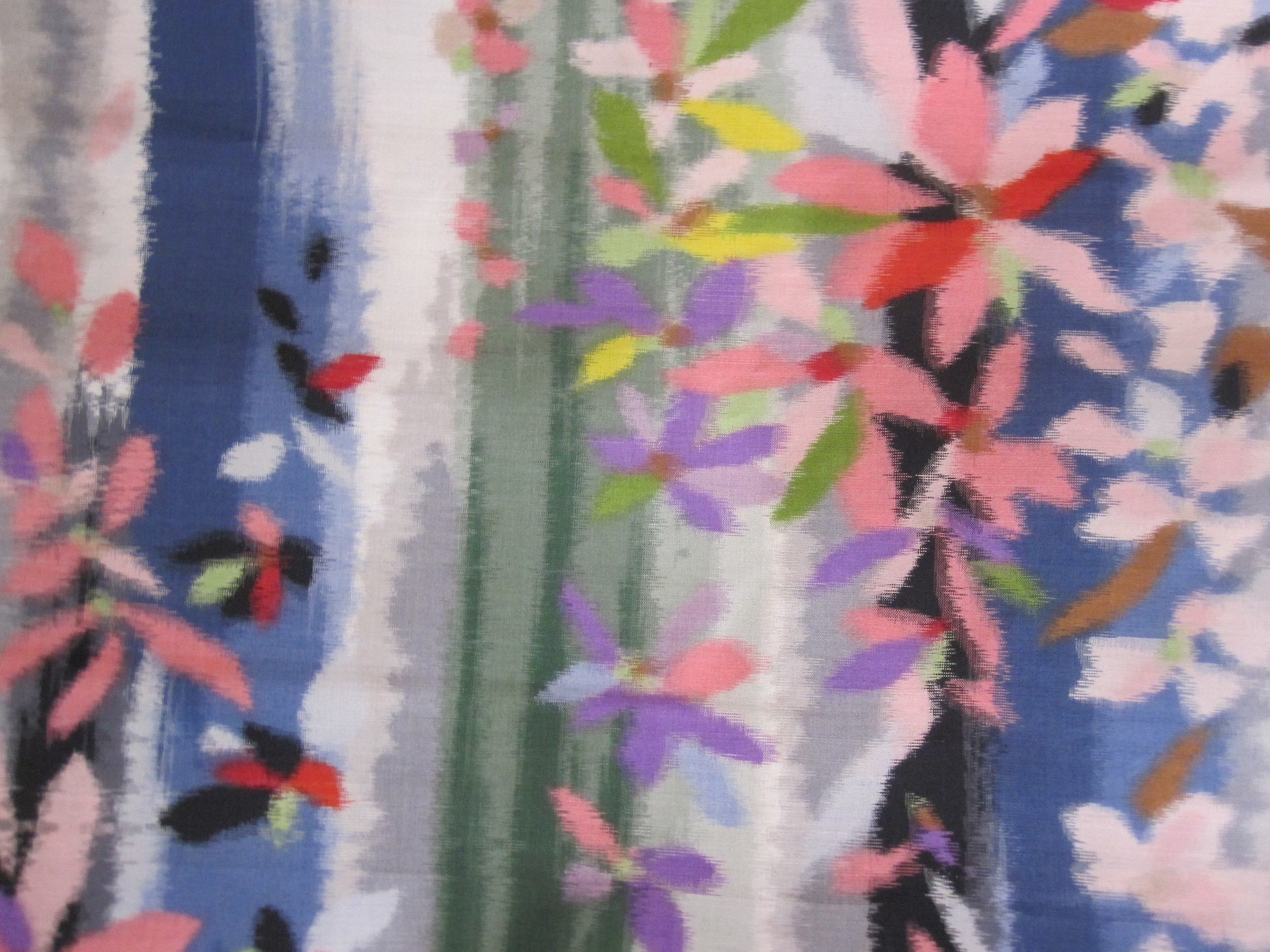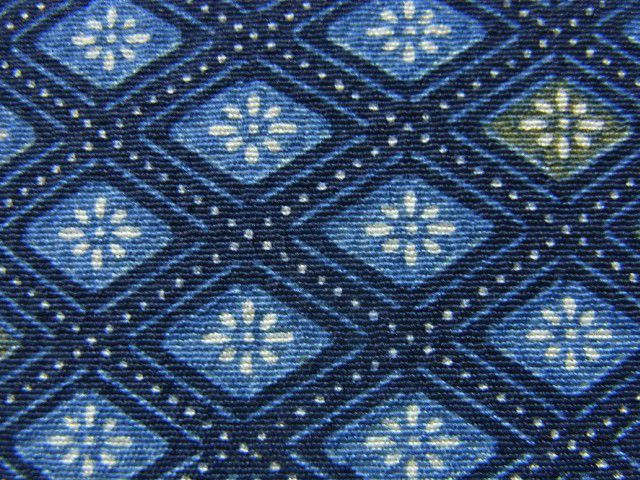Japanese kimono Fabrics
Japan is known throughout the world for its exquisite textiles, particularly for lavish and ornate ceremonial silk kimono with traditional motifs. Vintage kimono, those made from the 1950’s onward, however, are lesser known in the West. These heritage and vintage fabrics are the primary source of Faburiq's accessories. Country cottons such as kasuri have a unique beauty despite their humble use in rural settings. While very sturdy silks, such as meisen and omeshi, are the favored for kimonos and often feature bold contemporary designs reflecting their use by sophisticated urban women.
Japanese kimonos are made from bolts of fabric that are approximately between 13" to 15.5" wide. The fabrics are mostly originally intended to make women's kimonos, although some were intended for men's summer kimonos and boys' ceremonial kimonos such as the Rare Royal Palace Dolls Motifs (Gosho-Ningyo) fabrics. Faburiq's accessories are made with a variety of Japanese silks such as dead stock Meisen, Shibori, Omeshi, Tsumugi silk or Kasuri cotton and then finished with hand-rolled silk edges or hand-finished baby hems. At Faburiq, we use every inch of fabric bolt we obtain. Once the bolt is used, no pieces can be made with the same fabric again. Our accessories are a means of repurposing and breathing new life into fabrics that would otherwise have gone unworn and forgotten.
SILKS
Meisen is defined literally as 'common silk stuff' and has come back in popularity in the last few years. Meisen silk was a popular fabric for casual kimono from 1920 to 1950, due to it being affordable and in part because the designs, frequently drawing on Western influences, seemed adventurous at the time. Meisen is popular lately due to its stylized presentation of larger motifs and because it evokes the same feel as ikat (kasuri). Meisen silk, generally crisp and supple is one of the Japanese silks fabricated by weaving pre-dyed threads, utilizing the tie-and-resist ikat technique. In this process, the threads, silk or cotton, are first stretched on a frame. Selected design areas are tightly bound to prevent the dye from penetrating and the hanks of threads are immersed in the dye pots. The bound portions of the yarns resist the dye and when woven, as a result of the threads not being perfectly aligned, create shapes with charmingly uneven edges. Other Japanese textiles that are made with variations of this technique are cotton kasuri, omeshi silk and tsumugi silk.
Tsumugi originated with farmers who made use of cocoons left over after they had sold their best silk to market. They collected the floss from the cocoons, spin (tsumugi) it by hand into thread and weaved kimono for themselves. Stripes, checks and the splash pattern kasuri are the typical designs for Tsumugi. Yuki, Oshima, Kumejima and Tokamachi are well known for Tsumugi fabrics.
COTTONS
Cotton kasuri fabrics, very rugged and strong, are found mostly in Japan’s countryside. The fabric was originally made by farmer’s wives, and used as work clothes for their husbands. The whole process of dyeing and weaving was done by hand utilizing the tie-and-resist ikat method. The different motifs created when these pre-dyed threads are woven have charmingly soft, shimmering edges, as a result of the threads not being perfectly aligned. The dye originally used for kasuri was the intense blue extracted from the indigo plant, resulting in a fabric with tones of blue and white against a darker background. Many of Faburiq's cotton pocket squares are of this color hue.
TECHNIQUES
Kasuri is a Japanese word for fabric that has been woven with fibers dyed specifically to create patterns and images in the fabric. It is an ikat technique. The nature of ikat is that the design can look blurred, hence the name kasuri, which derives from the verb kasuru (to graze, to brush against; to take a percentage (from a person's salary, etc.); to write something (e.g. calligraphy) with little ink, i.e. in a blurry or scratchy manner) and is related to the intransitive verb kasureru (to touch lightly upon something, to scratch, to graze; to be blurred, to become scratchy, to become hoarse, to become husky). Notable examples of this fabric type are made in Fukuoka Prefecture, Kurume-gasuri; Ehime Prefecture, Iyo-gasuri; and Okinawa Prefecture, Ryukyu-gasuri. Learn more about Kasuri here.
Japanese tie-dyeing is called Shibori. In this dyeing method, lightweight silk is manipulated to create areas that resist the dyes. Stitching, folding, clamping, pole wrapping or binding the cloth before dyeing achieves a variety of effects. Most often the different areas are patterned by tightly wrapping tiny sections of the white silk with thread. When the fabric is dyed, the wrapped areas remain un-dyed, forming a pleasant, slightly irregular repeat pattern of tiny circles. The fabric may be allowed to retain its characteristic puckered surface or it may be ironed flat. Although this is a simple technique, it is very labor-intensive and requires great dexterity.
Yuzen is one of the most famous Kimono dyeing technique. The characteristics of "yuzen" are its hand paintings and picturesque patterns.
There are two main techniques of Yuzen: "tegaki-yuzen" (hand painted) and "kata-yuzen" (printed). Yuzen dyeing techniques use paste as the resist for dyeing the pattern. After the pattern is first sketched on the cloth using a juice squeezed from spiderworts, the paste is applied over this. Then, colors are added to the pattern according to the dye and pigment. Next, the completed pattern is covered with paste and the dye is added by a brush. After the colors are fixed, the paste is removed by waving the cloth in the running water. The beautiful patterns remain perfectly on the cloth. Every year in August, at the Kamo River in Kyoto, you can see many Yuzen artisans washing the rolls of the painted cloth in the running water. It is a beautiful scenery of Kyoto in August. Some of the various styles of "yuzen" were also developed in different regions: "Kaga-yuzen" (Kaga, Kanazawa), "Kyo-yuzen" (Kyoto), "Tokamachi-yuzen" (Tokamachi, Niigata) and "Nagoya-yuzen" (Nagoya). Learn more about Yuzen here.
Nishijin weaving, more narrowly referred to as Nishijin-ori (Nishijin fabric) is a traditional textile produced in Nishijin, a district in Kamigyō-ku, Kyoto, Japan. Nishijin produces the most sophisticated and lavish Obi you will find in Japan. The Nishijin style of weaving uses yarn dyeing, in which yarns of various colors are woven to make patterns. There are 20 steps in the manufacturing of a Nishijin fabric, from the growth of the silkworm to the weaving process. This weaving technique is both time-consuming and labor intensive compared to other techniques, but it is indispensable for creating the elaborate and gorgeous designs required for Obis. However, the industry has been quick to adopt innovations such as process mechanization and computer control to help reduce costs. The modern Nishijin industry continues to provide beautiful hand-woven fabrics, expressing designs that are distinct and discernible. Learn more about Nishijin here.
kimono fabric FACTS
Fabrics the color of shuiro red with a hint of orange background is traditionally believed to ward off evil spirits.
Komon kimono is the kind widely worn in town or visiting people. Small delicate patterns are equally distributed throughout the kimono. Those patterns are printed from woodblocks or dyed using stencils. Learn more about Komon here.
Meisen silk, generally crisp and supple, is one of the Japanese silks fabricated by weaving pre-dyed threads, utilizing the tie-and-resist ikat technique (ikat is an Indonesian term widely utilized to refer to this technique, which also happens to be a Malaysian word with the same meaning). Learn about Meisen here.
Mon is a family crest handed down through the generations. Most mon designs are based either on flowers or geometrical designs. However, a few are based on the animals of the zodiac, birds, or butterflies. Many of the popular mon are derived from ones once used by the aristocracy, particularly those used by members of the royal family. Most of the black formal haori, kimono or children's ceremonial kimono has those crests in white.
Shibori is a Japanese term for several methods of dyeing cloth with a pattern by binding, stitching, folding, twisting, compressing it, or capping. Some of these methods are known in the West as tie-dye. Today the exact work of shibori dyeing is carried out in the Arimatsu Narumi area of Aichi Prefecture and in parts of Kyoto Prefecture. Learn more about Shibori here.
Shichi-go-san is seven-five-three in Japanese. It is a gala day for children of three, five and seven years of age. On Novembr 15, parents take their children to a Shinto Shrine to offer prayers for their children's growth. The ages of three and five for boys and three and seven for girls are celebrated on that day. The children are dressed up in a gala kimono or fancy clothes to go to the shrines. There, they are given a thousand year candy, which is long and thin in paper bags with pictures of crane and turtles. Cranes and turtles are the symbols of longevity.






